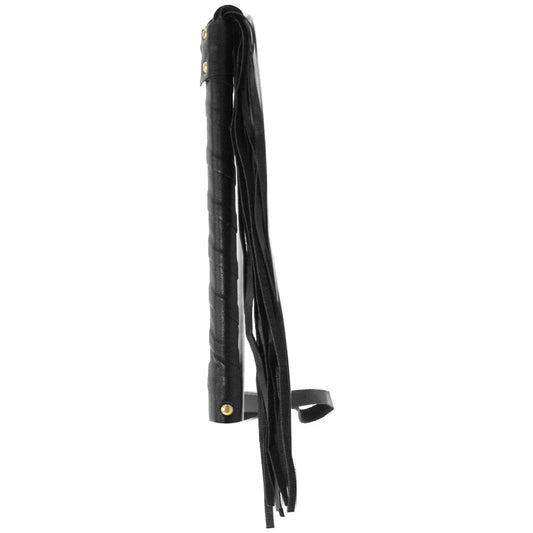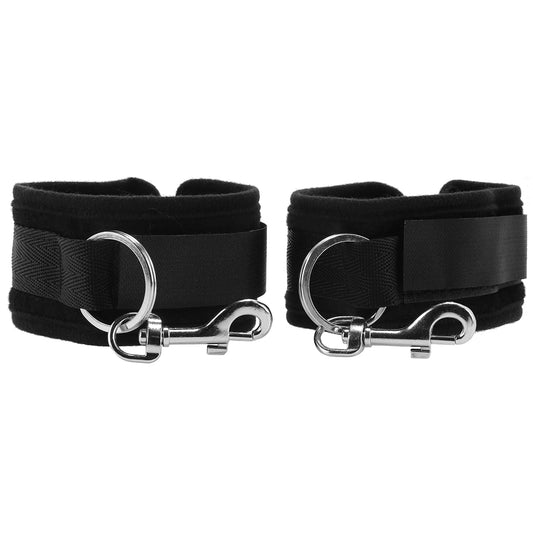
It’s been over a decade since the 50 Shades of Grey novel took the world by storm. Love it or hate it, we have to give the steamy trilogy credit for shining a light on BDSM play and pushing it a little or a lot into the mainstream. As attitudes about BDSM have shifted, and with more and more people exploring their kinky sides, sexual explorers are learning that there are a whole bunch of ways to enjoy BDSM play.
Even folks who know the basics and can distinguish the dominants from the submissives are learning that what those terms mean can differ - a lot. So, today we are exploring submissive play. We’ll talk about what it means to be a submissive and some of the different submissive types. Get ready to get kinky as we talk about the 5 types of submissives in BDSM!
What is BDSM?
Let’s start at the beginning. What exactly is BDSM? Well, first things first, “BDSM” is an acronym that stands for Bondage, Discipline (or Dominance), Sadism (or Submission), and Masochism. BDSM is an umbrella term for sexual activities that include physical restraint, power exchange, or pain. Sometimes BDSM and “kink” are used interchangeably, but that’s not always correct. In general, the BDSM lifestyle and activities are considered “kinky” (they fall outside the bounds of normative sexual behavior), but not all kinky things are BDSM.
Things to know about BDSM Play
There’s more to the BDSM lifestyle than grabbing some adult sex toys and getting down to it. In order to engage in safe and healthy bondage play, it’s important to remember some key points:
BDSM roles are for everyone. They are not dictated by gender or sexual orientation. Each role can be equally occupied by any person of any gender or sexual orientation.
There are no hard and fast “rules.” Outside of the general “everyone should be safe and consenting” stuff, each couple (or group or whatever) can decide their own rules/ways BDSM will work for them. Some folks will try to convince you that there is one “right” way to engage in BDSM, but as long as everyone is safe and satisfied, no one can tell you that the person you want to call “Daddy” should actually be called “Sir”.
Things are not always as they appear. Looking in from the outside, BDSM play may give the impression that there is one person in charge and another person being demeaned or humiliated. However, it’s VERY important to remember that all BDSM interactions are contingent on mutual, enthusiastic consent and enjoyment for all involved. For instance, it may seem like one partner is forcing the other to do things but even the “forced” looking scenarios are negotiated and agreed upon in advance. Additionally, they typically involve things like safe words that call all BDSM activity to a halt if someone is uncomfortable or if something goes wrong.
Submissives are powerful. To build on that last point, it may seem like a submissive is powerless and at the mercy of their dominant, but BDSM is an exchange of power. This means that the submissive partner agrees to the power dynamic. That requires trust and respect that, on the dominant’s end, must be earned. In short, far from being powerless, submissives actually have the power.
Think RACK. This acronym stands for Risk-Aware Consensual Kink. This means you are aware of the risks that come from whatever activity you are engaging in and know the steps you can take to mitigate said risks. Everyone needs to be 100% on board.
BDSM should be fun. Yes, there are a lot of things to think about and pay attention to, and you want to make sure everything is done safely and respectfully, but everyone involved should be enjoying themselves!
BDSM roles
BDSM play can feel like it comes with a language all its own, and that’s not incorrect. Example: activities that take familiar words and use them in a context that’s not what you’re used to, like Collaring, Sounding, and Edging. Then there’s all the tools involved (ball gags, cocklockers, and door swings, oh my!) and the many different roles one can take on.
We know we are here to get very specific about one set of roles - submissive - but first, let's have a quick overview of some of the broader terms that are used in BDSM.
Dominant
A dominant is the person who is in control during a BDSM scene. If there’s a flogger in a sexual play scenario, they are wielding it. If there are restraints being used, they are fastening them. If there are instructions a submissive needs to follow, the dominant is giving them.
Now, there is nuance to all of this, and it may look different from partner to partner. Some engage in what is known as “topping from the bottom,” where the dominant is actually the one receiving the flogging, etc. Additionally, though it’s easy to think of the different types of Dominants as “in charge”, BDSM play is collaborative, and each step requires consent.
Submissive
A submissive is the partner who surrenders to the control of their dominant. We’re going to get in-depth on this term in the next section, so just sit tight.
Switch
A switch is someone who feels comfortable in either the dominant or submissive role so they can switch (get it?) between the roles. Switches often prefer to not be tied to either role.
Some BDSM practitioners engage in what is known as TPE- Total Power Exchange. In this case, the dominant partner makes all decisions on behalf of the submissive partner. The submissive partner agrees to do what they are told, without arguments, and is punished (in accordance with a pre-negotiated agreement) if they challenge the dominant in any way. TPE can be exercised exclusively during playtime in the context of BDSM “scenes,” but many use the term to refer to relationships. Sometimes, the Total Power Exchange is a lifestyle choice that shapes the day-to-day lives of each partner, with the submissive dressing, cooking, cleaning, and behaving according to the dominant’s wishes.
What is a submissive in BDSM?
I gave you a short answer above but let's take a bit more of a deep dive into the term “submissive.” Frequently referred to as a “sub”, a submissive, frequently known as a sub, is a BDSM participant who consensually and willingly surrenders some or even all of their control to their dominant partner (often referred to as a “dom” or “Dom”) In the BDSM community this exchange of power is often referred to as a d/s or dom sub relationship.
Submissive is not a role that is dictated by gender, sexual orientation, body type, or anything really other than the desire to be submissive. A big, tough, burly dude can be a submissive just as much as a small, quiet woman can. It’s important to know that what it means to be submissive may vary from person to person and relationship to relationship. The big thing that submissives have in common is the ability to experience pleasure from whatever acts they and their dominant choose to engage in as well as the practice of pleasing their dominant.
For some submissives, there might be psychological components to the BDSM play such as degradation and humiliation. These would be negotiated and agreed upon in advance. Some submissives call their dominant by names like “Master,” “Mistress,” “Sir,” or “Ma’am.” D/s play can also include a whole array of physical acts, including but not limited to bondage, impact play, and torture games. These activities might involve bondage toys or other sex gear like paddles, floggers, whips, blindfolds, gags, spreader bars, rope, and more.
Some submissive acts include pain which, based on the preferences of the participants, can run the gamut from gentle and teasing to intense. Additionally, some submissives engage in acts that revolve around obedience. These can include begging for permission to orgasm or use the bathroom as well as role play and punishment.
As if all that was not enough, there are subtypes (no pun intended) to the category. Next, we are going to look at 5 different types of submissives. This list is by no means exhaustive, but it will give you a good idea about the variety of ways one can explore submission.
5 types of submissives
There are a whole lot of ways to be a submissive. This list features some options, but as we mentioned earlier on, there’s not really a hard and fast right or wrong way to apply these terms. If you like to think of yourself as a “bottom,” but the description of “brat” fits you to a t, go with it.
Bottom
First up we have a term that is often used interchangeably with “sub,” and that is “bottom.” This is a generic term for a submissive partner and is used to describe the person being spanked, restrained, teased, etc. Coming back to something we mentioned earlier, in BDSM, a bottom does not necessarily have to be the receptive partner. A dominant who is “topping” (get it? Top and bottom?) may order their bottom to penetrate them.
Slave
In the context of BDSM, a slave is someone who has (consensually) given themselves to their owner/dominant as property. Often a slave contract is involved, and this can outline everyone’s expectations, limits, duties, and desires. It might include things like daily routines, clothing, diet, acceptable sexual activity, and even whether a masterslave relationship will be monogamous or polyamorous. Such a contract can be voided at any time by either party.
It is also worth noting that while the master slave relationship dynamic can involve sex, it doesn’t have to. Some such relationships simply involve a slave who enjoys being at their dom’s disposal without sex being involved. As with anything, this is something the participants negotiate together.
Brat
For folks who enjoy sexual submission but also want to be a bit playful with it, there is the role of a brat. A brat might mischievously push their dom’s buttons or sassily break the rules resulting in some (consensual) punishment. Brats might enjoy provoking their dominant partner by leaving a mess and then receiving the spanking they deserve for their disobedience.
Good girl/Good boy
On the other end of the spectrum, from brats, we have Good Subs. These submissives get their kicks from following their dominant’s instructions and pleasing them. They are here for the obedience factor and get off on knowing they are their dom’s good girl/boy/gender neutral submissive.
Pet
Pets are pretty much what they sound like, submissives who enjoy playing the role of an animal for their dom. This can involve simply crawling on all fours, being a pet, and receiving hand feedings from their dominant but it can also include making animal noises, wearing a collar, and even using some animal accessories like ears or a fuzzy tail.
Those are 5 types of submissives but remember, there are many more! Additionally, there’s not really a “wrong” way to be a sub. You can negotiate any type of play you’d like with your partner. So if your thing is “submissive space creature” or “clown who is also a bottom” or whatever, go for it!
Are you sub-curious? Do you think you could be a great Pet? Or do you maybe just want some fun clothing and accessories to take your BDSM relationship to the next level? Whatever you’ve got in mind, Pink Cherry can hook you up! They’ve got all the bondage toys, bondage clothing, and bondage kits you need for a fun, safe, and sexy BDSM experience!




